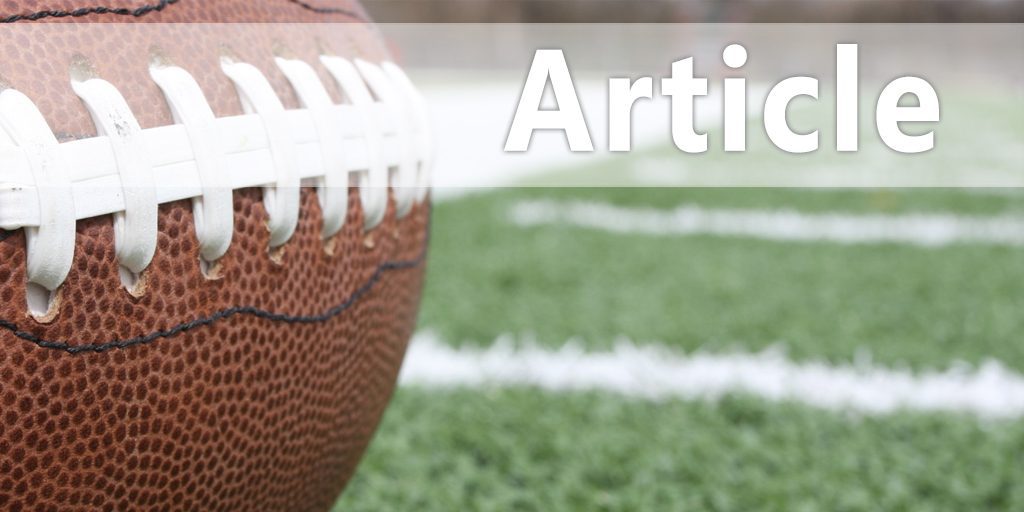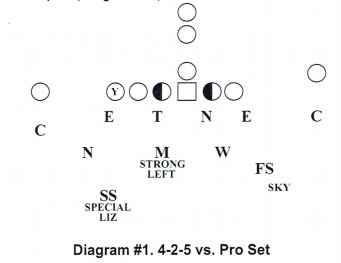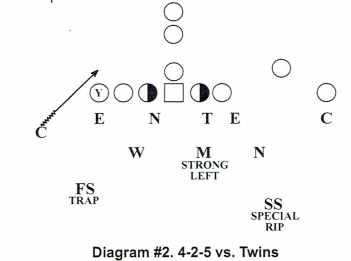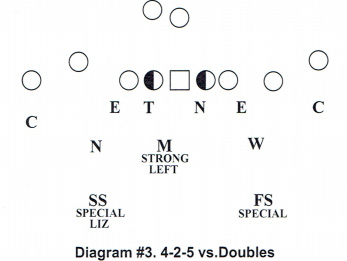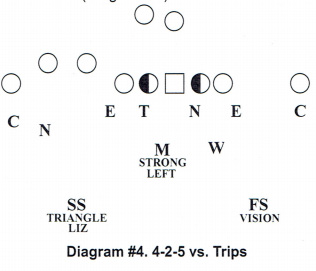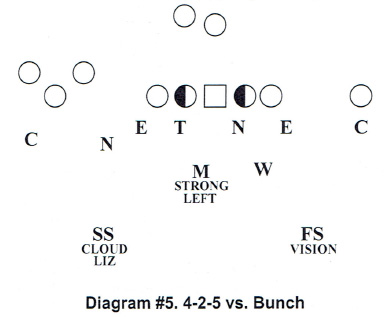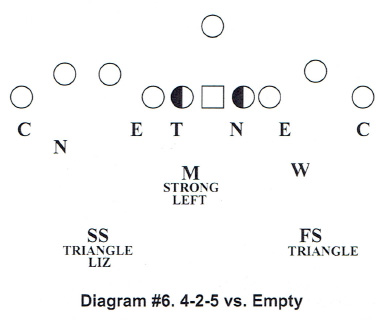| Quarter Coverage in the 4-2-5 Defense |
| By: Jimmie Tyson - Amos P. Godby HS (FL)
Originally Published in: Nike 2015 Coach of the Year Clinic Notes - by Earl Browning
I truly believe coaching is a ministry. It is about helping young men develop to be the best men they can be. This scripture is something that means a lot to me. It is what Jesus gave his disciples before he ascended to heaven. Go therefore and make disciples of all nations, baptizing them in the name of the Father and of the Son and of the Holy Spirit, teaching them to observe all that I have commanded you. And behold, I am with you always, to the end of the age. Matthew 28: 19-20 I believe this is a commandment that he has given to me, to make disciples. What the term means to me is as I go through my day-to-day life, is to be teaching, because disciple means to be a learner. As I come in contact with these young people that are learning, I want to teach them the ways of Christ. I believe we should be teaching these kids in a way that honors God. We often hear coaches talk Faith, Family, and Football. Your kids know if you believe that. You cannot talk about Faith, Family, and Football if you never talk about Faith. You cannot talk about Faith, Family, and Football if you never have your family around. Your kids realize whether you believe it or not. When you talk about defensive philosophy, there are a lot of great things out there. You hear we stop the run first, we are an attack style defense, or we play downhill defense. All of that is great. Again it comes down to two things. First, "Do you emphasize it?" And secondly, "Do you drill it?" Are you talking about it daily? When they go on the field and when they go in the film room are you emphasizing it daily? We said we were going to be a team that creates turnovers. We do turnover circuits to teach about turnovers. In the first four games we created 12 turnovers. In the next four games we only created two. We went back to figure out what happened. We realized that even though we were still doing our turnover circuits, we were not emphasizing turnovers in the later weeks. We had a coaches meeting and identified one coach to be the "Strip Coach." It is his job to emphasize turnovers every day. Our results sky rocketed up to our original results. Why? Because we were emphasizing it every day. The next thing to ask is, "Do you Drill It?" Are you drilling the things you say are important, every day? The things you see in your film study as areas that need improvement, are you drilling those things every day in practice? Are you creating drills that will help your players with what you want them to do? Are you using those drills every day? Do you see positive results from those drills in the game? If not, you probably need to make an adjustment. Do you emphasize it and do you drill it? What is a Loaf? We all have seen this and probably use it. We have made our modifications to fit what we are doing. WHAT IS A LOAF? • If You Change Speeds Before the Whistle Blows • No Burst to the Football • Staying Blocked • Turning Down Contact from the Ball Carrier • Lazy Stance • Celebrating by Yourself? Loafing = Being a Traitor We added the two last items this year. With all of the no-huddle tempo offenses we felt we needed to address our stance. Our offense is a fast-paced offense. They are fast in practice too. If you think it is hard calling defenses against us, try correcting your defensive kids while our offense is lined up to run the next play. We found our kids were not getting in good stances. We emphasize stance by making it a loaf if they are not in a good defensive stance before the ball is snapped. We also had some ego issues. We decided to emphasize that if you bring attention to yourself that is a loaf. We stated it as, "If you are too lazy to go find a teammate to celebrate with, then you are loafing." Every day in spring and summer practice we chart loafs. We make it loud. We do not want to hide it. If we see somebody loafing we call them out by name. Eventually you will have their teammates get on them and call them out. We tell them for every loaf above nine; it is half a gasser for each additional loaf. They basically have 9 loafs before they have to start running extra gassers. You may say that is a lot of loafs. For us, we could have 4 or 5 loafs on one play. In the beginning those numbers add up in a hurry. They start harping on each other to hustle and not to have any loafs. We emphasize it in the games too. Two years ago we implemented our game goals. DEFENSIVE GAME GOALS • 14 Points or Less • Single Digit Missed Tackles • Single Digit Loafs • 4 Takeaways • 3 or Less Explosive Plays (less than 19 yards) • Less than 100 Yards Rushing • 1 Sack Every 8 Passing Attempts • 7 Three-and-Outs • Less than 250 Yards of Total Offense After our Monday practice, for every point over 14, we run. On Tuesday, for every tackle we missed over 9, we run. On Wednesday, for every loaf we have over 9, we run for that too. As far as turnovers are concerned, we want to emphasize their importance. For every turnover we create we will take away from their extra running totals. When the kids start hearing we are at eight or nine loafs in practice, they start thinking they are going to have to do extra running after practice. They start to think they need to conserve their energy for after practice. We decided to give them ways to make up for loafs and missed tackles. Now instead of gearing down in practice, now they gear up because they know if they can get a fumble or an interception, they will not have to run as much or at all. Now they emphasize turnovers even more with each other. When we went back and looked at it, the number of explosive plays was crucial to how a defense performs in a game. If you are giving up big plays you are not doing a good job on defense. We really emphasize this on the defensive side of the ball. In the past we had a goal of three sacks per game. We changed that after we went to visit with the coaches at Vanderbilt. We play different types of offensive teams. A wing-T team may only throw the ball 3 times per game so it was an unrealistic goal. We have gone to using one sack for every eight passing attempts. We have a goal of seven, three-and-outs. We got this from Coach Mickey Andrews when he was at Florida State. This is probably the hardest goal for us to achieve. I think we were only successful twice this year in reaching that goal. When we talk about defensive philosophy we talk in terms of ARC and AFC. ARC = All Roads Closed • Stop the Run • Build a Wall • Gap-and-a-Half • Crush the Blockers • Set Edges • Gang Tackle AFC = All Flights Canceled • Stop the Pass • No Explosive Plays • Rush the QB • Create Turnovers • Understand Situations • Great Open-Field Tacklers I am sure your kids are like our kids in that they are all involved in social media. They are on Facebook, Twitter, Instagram, Snapchat and others. We use this and hashtag these things. You will see them gravitate to it by using the hashtags as well. After a good defensive practice where we stopped our offense in the run game we will post something like "#ARC — All Roads Closed." The players respond with these hashtags and it creates an excitement and focus. This is how we look at our defense. We want to stop the run. Everybody wants to stop the run. The way we stop the run is to build a wall. We are not penetrators. We want to build a wall and force everything east and west, Nothing goes north and south. Our defensive linemen are guys that hold fits. We want our linebackers to scrape and make all of the tackles. With that you have to make sure you are telling your tackles when they are doing a great job because they are sacrificing their numbers and their stats. You have to find a way to get those guys to buy into that. One way we do that is to celebrate our defensive linemen in our team defensive meetings. We give them a "hard hat" award that only goes to defensive linemen. It is not given for the number of sacks or anything like that. It is given for how they hold double teams and fits. It is given for their sacrifice to allow the linebackers to make plays. We emphasize to our linebackers to thank the defensive tackles if they had a good game and made a lot of tackles. We play what we call a gap-and-a-half defense. We got that from Rex Ryan when we heard him speak. The theory is that a good running back is probably going to make a defensive lineman miss if he is only responsible for one gap. We truly preach that they are responsible for their gap and half of their teammate's gap. If you do miss the runner just outside your gap, help is on its way. That is how we preach it. They are taught to fight off the block and get into the next gap. They have to make sure the ball is declared and we work hard on that. We believe in crushing blocks. As I said, we are not penetrators. We believe in knocking guys back. We call them knock-backs. We are going to make the ball carrier cut right now or bubble. You have to set edges on defense, especially if you are a spill team. If you want to force the ball east and west, you have to have guys who can set an edge. We preach about gang tackling. This is where loafs are involved. AFC is All Flights Canceled. You cannot be good at both, situationally. If we say we are going to stop the run we know we are going to have to give up some stuff in pass defense. You have to be okay with that. Sometimes you get excited as a defensive coordinator and get on kids when they gave up yardage. Sometimes you have to calm down and realize that is what we said we were going to have to give up. Our guys are not super football guys. We have to get them to buy in and to want to be good football players. We give them video sheets that they have to fill out to get them involved. It is a quiz about tendencies and opportunities for the opponent. We give them the questions and have them watch the opponent's film as homework. We can tell who is really watching and who is committed. A lot of times they are only watching their highlights and not the opponent. We were traditionally a 4-3 defensive football team. Once we looked at our personnel we decided to switch. Why the 4-2-5 • It Fits our Personnel • We can Play it to all Personnel and Formations • We can Play against Spread and Tempo Teams • We get 9 and 10 in the Box • We Free our Safeties Up to be Playmakers • We can Double Receivers We look at our personnel every year. We are in that process right now trying to determine what defense will fit us best. One thing about coaches, they do not like to make adjustments. They do not want to get out of their comfort zone, so they put the emphasis on the kids to change and do something they are not going to be good at. We do not believe in that. We believe in finding what our kids can do well and then we want to put them in a position to be successful. We look at our key personnel in the off-season and determine what scheme fits them. Going to a 4-2-5 fit our personnel last season. In our scheme, the nickel back is basically a big cornerback. He is really a cover guy. He is not like a safety that can cover but doesn't mind hitting somebody and being physical. We can get nine and ten guys into the box. The more guys you bring into the box, the more defenders we bring into the box. The more guys you spread out, the more guys we take out of the box. The big thing about how we play quarter's coverage is it frees up our safeties to be play-makers. I will talk more about what we do to allow our safeties to be playmakers. The 4-2-5 allows us to double on receivers depending on game planning. This is how we line up in our base defense. We have a strength call and a passing strength call. Our Mike linebacker gives us a strength call and our safety gives us a passing strength call. This is against a regular Pro formation. We keep it simple.
If it is an over front, we call it "Over." I once heard that football is a simple game made hard by coaches. We keep it simple. We run a base over front. We do some things just a little bit different. We line up in a 5-technique and a 3-technique. We play a 2i instead of a shade on the center. We feel we can restrict the B-gap better from a 2i. Plus, it is harder for the center to get to the 2i when he has to snap and move. If the nose is closer to him, it is easier for him to snap and step. Since we moved him to a 2i it has been very effective for us. We play a 6-technique against the tight end. We feel our defensive ends can crush the tight end and put him in the backfield. Of the 15 games we played this year there were only two tight ends who were the big physical prototypical types of tight ends. We felt good about the matchups where we could dominate the tight ends. We are not a super big front and we felt the 6-technique would give us more options. We can move and slant and really confuse the tight end from the 6-technique. He is a C-gap player. We can have him slant to the C-gap on one play and the next crush the tight end and fall back into the C-gap. Again, since we play gap-and-a-half, if it bounces he can come out and help. If it is a passing situation and based on our film study, we can play him at times in a 9-technique and loosen him up. We play our Nickel in a 90 or lose 9-technique. He is a force player. As I said we keep it simple. We call a 1 x 3, 2 x 3, 2 x 2, 3 x 1, and 3 x 2. We count the receivers from the outside in. If they can get that they can call all of our checks. We call our quarter's coverage "Special." We lock our corners. We feel like it gives us a good opportunity to be physical and play some good bump-and-run techniques. We truly believe in press man coverage. We do not play a soft press man. We re-route and move our feet. We try to disrupt routes and timing. The safety will call "special." The strong safety is telling everyone that if #2, the tight end in this case, goes vertical and clears the linebacker, he has him for that play. If the tight end clears the linebackers, our Nickel will drop off of #2 and becomes what we call a "vision and break" guy. He wants to clue back on the quarterback. If anything comes his way he can break on it. He is reading the quarterback and breaking on the ball. We believe the most important man is the man with the ball. I want eyes on the quarterback. I do not care what the route combination is. We play off of what the quarterback does. Mike is what we call a "3 dropper." He is always looking for #3 and he is going to drop off of #3. Because this is a 2 x 1, our free safety on the backside will give a "sky" call. Sky means he is going to come down to be the safety force. It gives us a bonus player in the box. With the "sky" call that tells the corner he has no help on the receiver and is man-to-man. It almost becomes a quarter, quarter, half type of coverage. If it is a pass, the Sky safety becomes a vision and break guy. Will plays the B-gap on a run. We want to spill the backside out to the safety. Against a 2 x 1 with a closed side, the Nickel goes to the passing strength. (Diagram #2) Remember we make a strength call and a passing strength call. The strong safety always travels with the Nickel to the passing strength. The Will always goes away from the passing strength. The free safety travels away from the passing strength. With our philosophy on defense our free safety is the bigger type of safety. Our strong safety is more of the athletic type who can the post.
If #2 goes out, the Nickle takes #2 and the strong safety becomes the vision and break guy. If #2 goes in, the Nickel makes an "In" call and he becomes a vision and break guy and the strong safety becomes a vision and break guy. We believe for every in, there is an out. If #2 goes in, the Nickel is looking for something coming out. If we get a closed side we make a "Trap" call on the backside for the free safety. The trap call tells the corner he is blitzing and the free safety has #1 to his side if he goes vertical. This gives us pressure built into our "Special" call. The end is a C-gap player, the tackle is a B-gap player, and Will is the A-gap player. The nose has the A-gap. If we see a 2 x 2 we line up like this. (Diagram #3)
The Nickle will split the difference or apex #2 and the end guy on the line. The Will does the same to his side. We have a "Special" call to both sides versus 2 x 2. If #2 goes vertical the free safety has him and the Will becomes vision and break. If #2 goes out, Will has him and the free safety becomes vision and break. If #2 goes in, the Will calls "IN, IN, IN" for the Mike. Will becomes a vision and break guy. The corner is locked and out of the equation. We are not worried about #1. We are worried about both #2 and #3. When we see a 3 x 1 or trips set we line up in this fashion. (Diagram #4)
On the trips side the corner is locked on #1 and they are out of the equation. The strong safety has a "Triangle" call. The Nickel takes outside leverage on #2. We have a triangle or three-over-two. The triangle is between Mike, the strong safety, and the Nickel, over the #2 and #3 receivers. If we get a vertical route by the #3 receiver, the strong safety has the vertical. If we get an in route by #2, the Mike has the in. The nickel becomes the vision and break guy. If they run a vertical and an out route the Nickel has the out route and the Mike becomes the vision and break guy. We work these combination routes with the linebackers, safeties and Nickel in practice. The corners work on their press coverage during this time. On the backside of a 3 x 1, the free safety gives a "Vision" call. It is pretty simple. It means the safety is going to vision the quarterback. We do not have him cheat to the middle of the field looking for #2 or #3 coming in because it leaves the corner to his side all by himself with no help. If the quarterback keeps it and runs to the single side, the quarterback will take him to the ball. He will cheat based on the quarterback. If the quarterback is able to look one way and come back and throw to the other side, we see that in our film study and plan accordingly. Peyton Manning can do it but in our world, quarterbacks are not looking off guys too often. That is said even knowing we play some highly nationally ranked quarterbacks. We believe the quarterback will take us to the ball at our level. One caveat is if on the 3 receiver side the #3 is an attached tight end, we can make a "sky" call which gives us and extra man in the box versus the run. This is done through game planning. If we see a bunch formation or stack formation this is how we line up. (Diagram #5)
We check a "cloud" call to the trips in this situation. It basically makes it a cover-2. The corner becomes a flat player, the nickel becomes a hash dropper, and the strong safety takes the half. This is our way of handling bunches and stacks in our special quarter's coverage defense. The free safety is a vision player reading the quarterback. If we see an empty backfield we call a triangle to both sides. (Diagram #6) We have three-over-two on the two receiver side. We lock the corner one-on-one to the trips side. We have three defenders over two receivers with the nickel, strong safety, and Mike to the trips side. Most teams that run an empty formation run the three receivers to the field. When we studied the film we found the field vertical to #1 is one of the least thrown passes. That is the farthest throw. We cheat the Mike linebacker over some. That is hard because he has A-gap responsibility and that puts him in a bind. He has to both help on #3 and play the A-gap. We can run a spike and slant the tackle to an A-gap responsibility, the end slants and has B-gap responsibility, and now the Mike can play the C-gap responsibility. It takes the pressure off of the Mike.
We play against a lot of different offensive concepts. Because of that we had to come up with something that was flexible enough to fit our personnel and allows us to defend against multiple types of offenses. We started our safeties out at 12 yards. After a few games we lined our safeties up at 10 yards and flat foot played it. After studying the film we felt our safety could play best from that position because we didn't want him to backpedal too much. This helped him come downhill versus the run. We are able to play press man with the corners but still have quarter's concepts. Against a tight end we play a catch technique. We want to absorb him, we want to collision him, and we are going to run with him. The tight end should not be able to run by us. If we play a world class tight end, we play him in a back pedal as if he was a good wide receiver. I want to thank everyone for listening. I appreciate you. |
